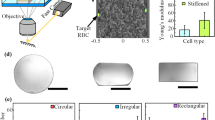Abstract
Red blood cells (RBCs) in microchannels has tendency to undergo axial migration due to the parabolic velocity profile, which results in a high shear stress around wall that forces the RBC to move towards the centre induced by the tank treading motion of the RBC membrane. As a result there is a formation of a cell free layer (CFL) with extremely low concentration of cells. Based on this phenomenon, several works have proposed microfluidic designs to separate the suspending physiological fluid from whole in vitro blood. This study aims to characterize the CFL in hyperbolic-shaped microchannels to separate RBCs from plasma. For this purpose, we have investigated the effect of hyperbolic contractions on the CFL by using not only different Hencky strains but also varying the series of contractions. The results show that the hyperbolic contractions with a Hencky strain of 3 and higher, substantially increase the CFL downstream of the contraction region in contrast with the microchannels with a Hencky strain of 2, where the effect is insignificant. Although, the highest CFL thickness occur at microchannels with a Hencky strain of 3.6 and 4.2 the experiments have also shown that cells blockage are more likely to occur at this kind of microchannels. Hence, the most appropriate hyperbolic-shaped microchannels to separate RBCs from plasma is the one with a Hencky strain of 3.
Similar content being viewed by others
References
Lima, R., Ishikawa, T., Imai, Y. & Yamaguchi, T. in In Single and two-Phase Flows on Chemical and Biomedical Engineering, edited by Ricardo Dias, Antonio A. Martins, Rui Lima and T.M. Mata (Bentham science, 2012), pp. 513–547.
Garcia, V., Dias, R. & Lima, R. in Applied Biological Engineering - Principles and Practice, edited by G. R. Naik (InTech, 2012), pp. 393–416.
Fedosov, D.A., Caswell, B., Popel, A.S. & Karniadakis, G.E. Blood flow and cell-free layer in microvessels. Microcirculation (New York, N.Y.: 1994) 17, 615–628 (2010).
Kim, S., Ong, P.K., Yalcin, O., Intaglietta, M. & Johnson, P.C. The cell-free layer in microvascular blood flow. Biorheology 46, 181–189 (2009).
Namgung, B., Liang, L. & Kim, S. in Visualization and Simulation of Complex Flows in Biomedical Engineering, edited by R. Lima, Y. Imai, T. Ishikawa and M. S. N. Oliveira (Springer Netherlands, 2014), Vol. 12, pp. 75–87.
Abkarian, M. et al. Cellular-scale hydrodynamics. Biomed. Mater. 3, 034011 (2008).
Pinho, D., Yaginuma, T. & Lima, R. A microfluidic device for partial cell separation and deformability assessment. BioChip J. 7, 367–374 (2013).
Lee, S.S., Yim, Y., Ahn, K.H. & Lee, S.J. Extensional flow-based assessment of red blood cell deformability using hyperbolic converging microchannel. Biomed Microdevices 11, 1021–1027 (2009).
Faustino, V. et al. Extensional flow-based microfluidic device: deformability assessment of red blood cells in contact with tumor cells. BioChip J. 8, 42–47 (2014).
Faustino, V. et al. in Visualization and Simulation of Complex Flows in Biomedical Engineering, edited by R. Lima, Y. Imai, T. Ishikawa and M. S. N. Oliveira (Springer Netherlands, 2014), Vol. 12, pp. 151–163.
Yaginuma, T., Oliveira, M.S.N., Lima, R., Ishikawa, T. & Yamaguchi, T. Human red blood cell behavior under homogeneous extensional flow in a hyperbolic-shaped microchannel. Biomicrofluidics 7, 054110 (2013).
Sousa, P.C., Pinho, F.T., Oliveira, M.S. & Alves, M.A. Extensional flow of blood analog solutions in microfluidic devices. Biomicrofluidics 5, 14108 (2011).
James, D.F., Chandler, G.M. & Armour, S.J. Measurement of the extensional viscosity of M1 in a converging channel rheometer. J. Nonnewton. Fluid. Mech. 35, 445–458 (1990).
Oliveira, M.N., Alves, M., Pinho, F. & McKinley, G. Viscous flow through microfabricated hyperbolic contractions. Exp. Fluids 43, 437–451 (2007).
Brust, M. et al. Rheology of Human Blood Plasma: Viscoelastic Versus Newtonian Behavior. Phys. Rev. Lett. 110, 078305 (2013).
Sousa, P.C., Pinho, F.T., Oliveira, M.S.N. & Alves, M.A. Efficient microfluidic rectifiers for viscoelastic fluid flow. J. Nonnewton. Fluid. Mech. 165, 652–671 (2010).
Lopes, A. The study of the effect of microcontractions in the separation of blood cells: soft lithography and micromilling. Polytechnic Institute of Bragança (2014).
Pinto, E. et al. A rapid and low-cost nonlithographic method to fabricate biomedical microdevices for blood flow analysis. Micromachines 6, 121–135 (2015).
Pinho, D., Lima, R., Pereira, A.I. & Gayubo, F. Automatic tracking of labeled red blood cells in microchannels. Int. J. Numer. Method Biomed. Eng. 29, 977–987 (2013).
Author information
Authors and Affiliations
Corresponding author
Rights and permissions
About this article
Cite this article
Rodrigues, R.O., Lopes, R., Pinho, D. et al. In vitro blood flow and cell-free layer in hyperbolic microchannels: Visualizations and measurements. BioChip J 10, 9–15 (2016). https://doi.org/10.1007/s13206-016-0102-2
Received:
Accepted:
Published:
Issue Date:
DOI: https://doi.org/10.1007/s13206-016-0102-2




